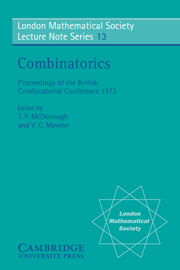Book contents
- Frontmatter
- Contents
- Preface
- Papers contributed by the participants
- Perfect codes and distance-transitive graphs
- Generalisation of Fisher's inequality to fields with more than one element
- On balanced arrays
- Positions in Room squares
- Analogues of Heawood's theorem
- Cut-set lattices of graphs
- On the chromatic index of a graph, II.
- On a theorem of R. A. Liebler
- Outerthickness and outercoarseness of graphs
- Graphs with homeomorphically irreducible spanning trees
- A note on embedding latin rectangles
- Some results in semi-stable graphs
- Hereditary properties and P-chromatic numbers
- Some problems concerning complete latin squares
- Necklace enumeration with adjacency restrictions
- On a family of planar bicritical graphs
- On the enumeration of partially ordered sets of integers
- The distance between nodes in recursive trees
- Partition relations
- On a problem of Daykin concerning intersecting families of sets
- Unstable trees
- Distance-transitive graphs
- Enumeration of graphs on a large periodic lattice
- Some polynomials associated with graphs
- Equidistant point sets
- Eigenvalues of graphs and operations
- Graph theory and algebraic topology
- Applications of polymatroids and linear programming to transversals and graphs
- Problem section
Necklace enumeration with adjacency restrictions
Published online by Cambridge University Press: 05 April 2013
- Frontmatter
- Contents
- Preface
- Papers contributed by the participants
- Perfect codes and distance-transitive graphs
- Generalisation of Fisher's inequality to fields with more than one element
- On balanced arrays
- Positions in Room squares
- Analogues of Heawood's theorem
- Cut-set lattices of graphs
- On the chromatic index of a graph, II.
- On a theorem of R. A. Liebler
- Outerthickness and outercoarseness of graphs
- Graphs with homeomorphically irreducible spanning trees
- A note on embedding latin rectangles
- Some results in semi-stable graphs
- Hereditary properties and P-chromatic numbers
- Some problems concerning complete latin squares
- Necklace enumeration with adjacency restrictions
- On a family of planar bicritical graphs
- On the enumeration of partially ordered sets of integers
- The distance between nodes in recursive trees
- Partition relations
- On a problem of Daykin concerning intersecting families of sets
- Unstable trees
- Distance-transitive graphs
- Enumeration of graphs on a large periodic lattice
- Some polynomials associated with graphs
- Equidistant point sets
- Eigenvalues of graphs and operations
- Graph theory and algebraic topology
- Applications of polymatroids and linear programming to transversals and graphs
- Problem section
Summary
Introduction
Let G, H be two finite graphs (possibly with loops but with no multiple edges) having vertex sets V(G), V(H) and edge sets E(G), E(H). An edge joining vertices u and v is denoted by [u, v] and, therefore, a loop at u by [u, u], A function f : V(G) → V(H) is called a homomorphism if it preserves adjacencies, i. e. if [u, v] ∈ E(G) implies [f(u), f(v)] ∈ E(H). The set of all such homomorphisms is denoted by hom(G, H). The set of all one-one homomorphisms from G to itself forms the automorphism group of G denoted by aut(G). It is often desirable to regard f, g ∈ hom(G, H) as equivalent if there exists a ∈ aut(G) such that f = ga. The set of equivalence classes is denoted by hom(G, H)/aut(G).
A colouring of a graph G is a function k : V(G) → C where C is a finite set whose elements are called colours. The following general problem is of some interest: how many colourings of G are there subjec to certain specified adjacency restrictions - i. e. as well as C a matrix B is given with (B)ij = 1 (or 0) if colour i may (or may not) be adjacent to colour j. Of course, B may be regarded as the adjacency matrix of a graph H. Each colouring of G (subject to the restrictions) corresponds to an element of hom(G, H) and conversely.
Information
- Type
- Chapter
- Information
- Combinatorics , pp. 97 - 102Publisher: Cambridge University PressPrint publication year: 1974
